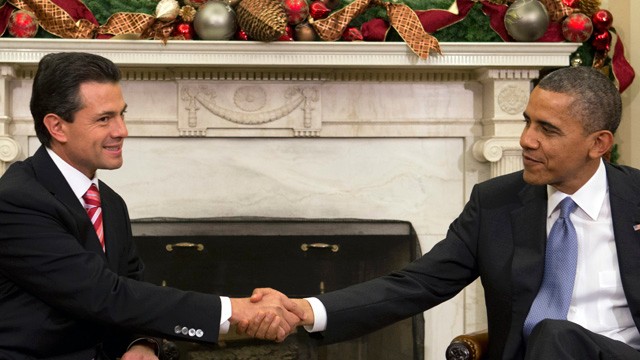by Garrett Okonek
Think of Schrödinger’s cat, a thought experiment in which a cat is left inside a box with a vial of poison. The vial may break and kill the cat. Or it might not. While the lid is closed, there is no way of knowing whether the vial broke. The cat can be thought both alive and dead. Either option is possible. Unless you open the box, you can’t really tell. This is Mexico today. Everything could be happening. Or nothing.
The country is in the midst of a crisis that, up until a few months ago, seemed unlikely. The government was passing structural and constitutional reforms in order to open up the state-owned oil company and to wrest education control from the teachers’ union, by changing the way they were evaluated, among other things. These changes earned widespread international acclaim. The Economist called President Enrique Peña Nieto’s election “Mexico’s moment.” In a cover story earlier this year, Time magazine proclaimed the president was “Saving Mexico.”
In retrospect, these supposedly monumental changes were built on a house of cards. The reforms came tumbling down almost as soon as the government tried to enact them. Oil, which makes up a third of Mexico’s revenue, has dropped in price and will continue to fall throughout 2015, according to local and international forecasts. Investors may not come flocking in as the government expected, despite efforts to privatize the oil industry, currently controlled entirely by Pemex, the state-owned oil company. The teachers are fighting back too and have stopped the enactment of the new laws in some states. And most important, Mexico’s weak rule of law, a subject no one was talking about until recently, has now garnered a global spotlight.
Tensions have come close to a breaking point over the last few weeks because of two different but equally gruesome events. First, in June the army executed 22 civilians in Tlatlaya, a small town in southeastern Mexico state. Officials said the military discovered a kidnapping ring during a scheduled patrol and fought the kidnappers, killing all of them. According to witnesses, however, those killed were not criminals, but the army executed them anyway. On Sept. 26, police killed six college students and 43 others went missing in Iguala, about 80 miles south of Mexico City. The 43 students were seized by local police and then reportedly handed over to a local drug cartel. Activists say the government worked alongside organized crime to abduct and then, in all likelihood, kill the students.
There have been few and contradictory answers. The government has given several press conferences and arrested almost 100 people, but nearly two months later, it cannot even confirm whether the missing students are dead or alive. Since October, thousands have taken to the streets in almost weekly protests. On Nov. 8, during a large and otherwise peaceful march to the Zócalo, the capital’s central square, a small group of people set fire to one of the doors of the National Palace, the president’s office. The flames were quickly contained, but the image circled the globe. Mexico was on fire.
A week later, investigators from Mexico City’s district attorney office who were responding to an alleged cellphone theft at the National Autonomous University fired shots, and a student was injured. Dozens of riot police were called in, and for a while it appeared the situation could quickly escalate — like almost everything else in Mexico at the moment.
“Peña Nieto’s refusal to address the ongoing political turmoil underscores one inescapable fact: Corruption and crime do not have consequences in Mexico.”
Meanwhile, Peña Nieto was preparing to fly halfway around the world, to China, to tout his government’s job creation and strong economic record. Before his election, Mexico’s economy was forecast to grow at a rapid rate. It has registered dismal 2.5 percent growth since he took office in 2012, while recession has been rearing its head.
On Nov. 7, Attorney General Jesús Murillo Karam delivered grisly news, saying Iguala police abducted the 43 missing students and handed them over to a drug cartel, which killed them and burned their bodies. Peña Nieto, who at the time was meeting with businessmen in Mexico City, addressed the issue for five minutes. He then returned to the important topic at hand: job creation. No national address or apology for his government’s botched handling of the crisis, just a five-minute mention, as if the mass slaughter of the students were only a mild inconvenience. Remarkably, he even apologized to the businessmen he was meeting with because he couldn’t stay for dinner.
A day later, as the president was en route to China for this year’s Asia-Pacific Economic Cooperation summit, the online news site Aristegui Noticias broke a massive investigative story: Peña Nieto had built a private mansion with a cost of $6.5 million. That was not even the most important part of the story. Painted entirely white and dubbed the White House by the press, the mansion was built by Grupo Higa, a company that won most of the major infrastructure contracts in the state of Mexico while Peña Nieto was its governor and recently received another big contract, along with a Chinese consortium, to build the country’s first high-speed railway. The president abruptly canceled the contract a few hours before the news went online. But it was too little, too late.
His office later issued a statement saying the house was sold to his wife in monthly payments. No word on the clear conflict of interest; she bought a mansion built and financed specifically for her by one of the government’s main contractors. Like the case of missing students, Peña Nieto refused to talk about the issue on his seven-day international tour and only briefly addressed it at a press conference since he returned, off-handedly acknowledging that the story was published while he was away on business. During a small press conference on Tuesday, Peña Nieto went one step further. He characterized the reports as inaccurate and hinted that the reporters were not on board with “the national project,” suggesting they were trying to sabotage it.
The army shot and killed 22 civilians after they surrendered. The local police and government that kidnapped the missing students were infiltrated by the cartels. And from what little he has said so far, Peña Nieto doesn’t seem to think there is a problem with receiving a mansion from a government contractor. Those three horrible events underscore one inescapable fact: Corruption and crime do not have consequences in Mexico.
Peña Nieto has defined corruption, Mexico’s largest hindrance, as a cultural matter. No wonder, then, the fallout from the White House scandal and the plight of the missing students has been minimal so far, with the harshest criticism coming mostly from the international press. In fact, no high-ranking official had been held accountable for these crimes. A few soldiers were arrested after details of the execution leaked to show that the government was investigating the case of 22 civilians gunned down in June. The mayor of Iguala and his wife were arrested earlier this month in connection with the students’ disappearance after being on the run for nearly a month. The crime was treated and continues to be spun as an isolated issue by the Mexican media and government.
That is the crux of the problem and why Mexico can be compared to Schrödinger’s cat. As the country teeters ever closer to the abyss, the government goes on as usual, pretending nothing is happening. It has worked in the past. If you wait long enough, people will forget or simply accept the grimness they face. Corruption and the lack of rule of law has become another fact of everyday life. The conventional wisdom seems to be that corruption and violence are rampant but unpreventable.
Protesters across the country are planning to take to the streets on Nov. 20, on the 104th anniversary of the National Revolution, which deposed long-reigning autocrat Porfirio Díaz. Meanwhile, the government is doing what it does best: deflecting attention from the problems.
Only after we open the box will we see whether something actually happened in Mexico or things stayed exactly the same as before.
[divider]




